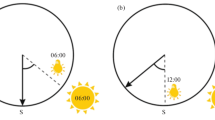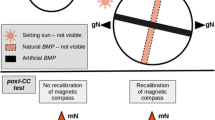Summary
The Bobolink appears to use an integrated orientation system involving at least a star compass and a magnetic compass. The magnetic compass appears to provide the primary reference for the system and the star compass serves as a secondary compass. The star compass appears to be checked against the magnetic compass every 1 to 5 nights, and adjusted to compensate for changes in the relative locations of star patterns. These results are in agreement with those of other species where both the star compass and the magnetic compass have been investigated. Such an integrated orientation system is advantageous to a transequatorial migrant because the night sky changes greatly between the beginning of its journey and the end, even from night to night; and the horizontal magnetic field at the equator is unusable as a dip compass.
Zusammenfassung
Der Reisstärling scheint ein integratives Orientierungssystem zu benutzen, das einen Sternkompaß, einen Magnetkompaß und möglicherweise noch weiter Faktoren einschließt. Dabei stellt der Magnetkompaß wohl das primäre Referenzsystem dar, während der Sternkompaß als sekundärer Kompaß dient. Der Sternkompaß wird alle 1 bis 5 Nächte mit dem Magnetkompaß verglichen und nachgeeicht, um Veränderungen der Stellung der Sterne zu kompensieren. Die Befunde stimmen mit denen an anderen Arten überein, bei denen sowohl Sternkompaß als auch Magnetkompaß untersucht wurde. Für einenm Transäquatorialzieher ist solch ein integratives Orientierungssystem von Vorteil, da sich einerseits der Sternhimmel von Beginn bis Ende des Zuges, sogar von Nacht zu Nacht, verändert und das horizontale Magnetfeld am Äquator andererseits für einen Inklinationskompaß unbrauchbar ist.
Similar content being viewed by others
Literature
Able, K. P. (1980): Mechanism of orientation, navigation and homing. In:Gauthreaux, S. A. (ed.): Animal migration, orientation and navigation. New York, Academic: 283–373.
Ditto (1982a): Skylight polarization patterns at dusk influence migratory orientation in birds. Nature 299: 550–551.
Ditto (1982b): The effects of overcast skies on the orientation of free-flying nocturnal migrants. In:Papi, F., &H. G. Wallraff (eds.): Avian Navigation, Springer Verlag, Berlin: 38–49.
Alerstam, T., &G. Hogstedt (1983): The role of the geomagnetic field in the development of birds' compass sense. Nature 306: 463–465.
Amer. Ornithol. Union (1983): Check-list of North American birds. 6th ed., Lawrence, KS, Allen Press.
Batschelet, E. (1965): Statistical methods for the analysis of problems in animal orientation and certain biological rhythms. Amer. Inst. biol. Sci., Washington.
Ditto (1978): Second-order statistical analysis of directions. In:Schmidt-Koenig, K., &W. T. Keeton (eds.): Animal migration, navigation, and homing. Berlin, Springer-Verlag: 1–24.
Ditto (1981): Circular statistics in biology. New York, Academic.
Beason, R., C. &J. E. Nichols (1984): Magnetic orientation and magnetic material in a transequatorial migratory bird. Nature 309: 151–153.
Bellrose, F. C. (1967): Radar in orientation research. Proc. XIV Int. Ornithol. Congr.: 281 f.
Bingman, V. P. (1981): Savannah Sparrows have a magnetic compass. Anim. Behav. 29: 962–963.
Ditto (1983a): Importance of earth's magnetism for the sunset orientation of migratory naive Savannah Sparrows. Monit. zool. Ital. (NS): 17: 395–400.
Ditto (1983b): Magnetic field orientation of migratory Savannah Sparrows with different first summer experience. Behaviour 87: 43–53.
Ditto (1984): Night sky orientation of migratory pied flycatchers raised in different magnetic fields. Behav. Ecol. Sociobiol. 15: 77–80.
Childs, S. B., &E. R. Buchler (1983): Misuse of orientation statistics. Can. J. Zool. 60: 475–477.
Emlen, S. T. (1969): The development of migratory orientation in young indigo buntings. Living Bird 8: 113–126.
Ditto (1970): Celestial rotation: Its importance in the development of migratory orientation. Science 170: 1198–1201.
Ditto (1972): The ontogenetic development of orientation capabilities. NASA Spec. Publ. 262: 191–210.
Ditto (1980): Decision making by nocturnal bird migrants: the integration of multiple cues. Proc. 17th Int. Ornithol. Congr. Berlin: 553–560.
Ditto &J. T. Emlen Jr. (1966): A technique for recording migratory orientation of captive birds. Auk 83: 361–367.
Ditto, &S. Bergmann (1976): Magnetic direction finding: evidence for its use in migratory indigo buntings. Science 193: 505–508.
Fiore, L., L. Geppetti, A. Mancino &P. Mela (1984): Short-term effect of horizontal geomagnetic field deflections on the oriented behavior of caged robins,Erithacus rubecula (L.). Monit. zool. Ital. (NS) 18: 123–131.
Griffin, D. R. (1973): Oriented bird migration in or between opaque cloud layers. Proc. Amer. Phil. Soc. 117: 117–141.
Hamilton, W. J., III. (1962): Bobolink migratory pathways and their experimental analysis under night skies. Auk 79: 208–233.
Keeton, W. T. (1979): Avian orientation and navigation: a brief overview. Brit. Birds 72: 451–470.
Kiepenheuer, J. (1984): The magnetic compass mechanism of birds and its possible association with the shifting course direction of migrants. Behav. Ecol. Sociobiol. 14: 81–99.
Mardia, K. V. (1972): Statistics of directional data. New York, Academic.
Merkel, F. W., &W. Wiltschko (1965): Magnetismus und Richtungsfindungen zugunruhiger Rotkehlchen (Erithacus rubecula). Vogelwarte 23: 71–77.
Meyer de Schauensee, R. (1966): The species of birds of South America and their distribution. Narbeth, AA.
Moore, F. R. (1980): Solar cues in the migratory orientation of the Savannah Sparrow,Passerculus sandwichensis. Anim. Behav. 28: 684–704.
Moreau, R. E. (1972): The Palearctic-African bird migration systems. New York, Academic.
Ossenkopp, K.-P., &R. Barbeito (1978): Bird orientation and the geomagnetic field: a review. Neurosci. and Biobehav. Rev. 2: 255–270.
Schmidt-Koenig, K. (1984): Elements of bird migration. In: Localization and orientation in biology and engineering.Varju, Schnitzler (eds.): 325–336.
Walcott, C. (1980): Magnetic orientation in homing pigeons. IEEE Trans., MAGIG: 10008–1013.
Wiltschko, R., &Wiltschko, W. (1978): Relative importance of stars and magnetic field for the accuracy of orientation in night-migrating birds. Oikos 30: 195–206.
Wiltschko, W. (1982): The migratory orientation of Garden Warblers,Sylvia borin. In:Papi, F., &H. G. Wallraff (eds.): Avian Navigation. Springer-Verlag, Berlin: 50–58.
Ditto (1983): Compasses used by birds. Comp. Biochem. Physiol. 76A: 709–717.
Ditto,E. Gwinner &R. Wiltschko (1980): The effect of celestial cues on the ontogeny of non-visual orientation in the garden warbler (Sylvia borin). Z. Tierpsychol. 53: 1–8.
Ditto &R. Wiltschko (1975a): The interaction of stars and magnetic field in the orientation system of night migrating birds. I. Autumn experiments with European warblers (Gen.Sylvia). Z. Tierpsychol. 37: 337–355.
Ditto (1975b): The interaction of stars and magnetic field in the orientation system of night migrating birds. II. Spring experiments with European Robins (Erithacus rubecula). Z. Tierpsychol. 39: 265–282.
Zar, J. H. (1974): Biostatistical analysis. Englewood Cliffs, NJ, Prentice-Hall.
Author information
Authors and Affiliations
Rights and permissions
About this article
Cite this article
Beason, R.C. Interaction of visual and non-visual cues during migratory orientation by the Bobolink (Dolichonyx oryzivorus). J Ornithol 128, 317–324 (1987). https://doi.org/10.1007/BF01640301
Published:
Issue Date:
DOI: https://doi.org/10.1007/BF01640301




